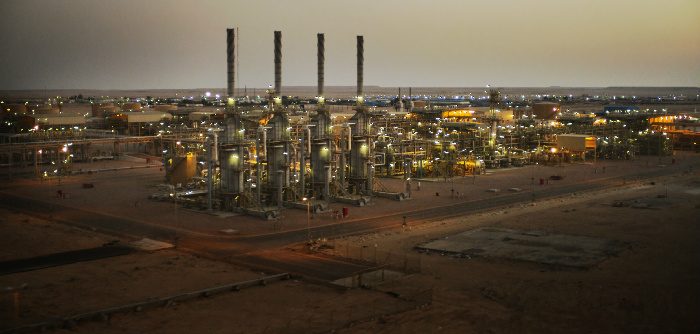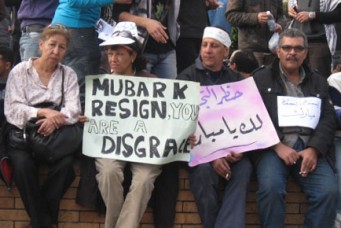Egypt Re-Energized: An Industry Report
As new discoveries of natural gas deposits are made in Egypt and an interest in renewable energy resources arises, this industry report forecasts good times ahead for the North African country.

Salam natural gas plant in Egypt’s Western Desert. Courtesy of Apache Corporation
Egypt boasts a rich oil and gas history dating back to 1886. Over the last 125 odd years, the country’s petroleum industry has seen mostly good times, but the last two decades have seen downtimes too, most recently in its failure to meet domestic energy demand. The situation is looking up once again, but there are plenty of challenges.
Upcoming changes will be both social and technological. Egyptians have long enjoyed energy subsidies making fuel and electricity affordable, but this governmental band-aid was never sustainable. Many are acutely feeling the pains of recent austerity measures by President Abdel Fattah El-Sisi’s government. If the government follows through on its reform measures, the situation should indeed improve the socioeconomic lot for the average citizen, and the country as a whole.
Technologically, the country will put a greater focus on natural gas production in the near term, as well as enhanced oil recovery techniques. However, more importantly, renewable energy is set to take a significant role in the future of Egyptian power generation. This development has several implications. First, the industry will see plenty of foreign direct investment aligned with the global initiative to fight climate change. Second, the further development of its renewable energy sector will result in long-term job creation. Third, Egypt has severe pollution problems and renewable energy can contribute to cleaning up the environment, both domestically and globally, by utilizing a clean and sustainable power supply. And lastly, some of Egypt’s natural gas and crude oil will be freed up for export, adding to its revenues base.
Recent History
Long a producer and exporter of crude oil, Egypt saw its production from existing oilfields begin to decline in the mid-1990s, ultimately becoming a net oil importer in 2007. This turn of events, combined with Egypt’s explosive population growth over the last two decades (going from around 66 million in 1997 to over 97 million at current estimates), has resulted in the country’s energy demand vastly outstripping available supplies—from all sources—including renewable energy. At the turn of the century, however, significant natural gas discoveries in the Mediterranean boosted investor confidence and the country bustled with excitement at the promise of riches this “other” hydrocarbon resource would bring. This newly discovered resource became the answer to an economic prayer, or so it was thought.
Major oil and gas companies from around the world were eager to help Egypt monetize this resource and agreements were quickly put in place to construct two liquified natural gas (LNG) export terminals, one at Idku (on the Mediterranean coast just east of Alexandria), the other at Damietta (also on the coast), just 60 kilometers from the mouth of the Suez Canal. The construction of these two facilities was undertaken at a lightning pace from breaking ground to completion. The first LNG exports came in December 2004 from the Damietta facility and in May 2005 from Idku. With buyers lined up and contracts in place, foreign currency earnings bolstered the Egyptian economy, and declining oil production was no longer an overriding concern.
Egypt became the King of the Mediterranean region with two world-class LNG projects under its belt. The export possibilities were endless at a time when European nations were desperately trying to diversify supply sources and lessen their dependence on Russian oil and natural gas. Meanwhile, rapid growth in Asian energy demand contributed to a very lucrative LNG export game.
Life was good, for a time.
But as years went by the effects of a population explosion and the growth of its industrial base required more power resources. This eventually resulted in natural gas contracted for LNG export markets being diverted to domestic facilities. The power situation became so dire that countrywide power cuts became a daily occurrence, with electricity use hitting a record daily high in August 2014 of 27,700 megawatts (MW), 20 percent more than the national grid could provide.
It was apparent the country had hit a critical juncture and decisive governmental action was needed.
As a result, the LNG export facility operators found themselves increasingly unable to meet their global export supply obligations, as natural gas receipts decreased each year. By February 2013, the plant at Damietta had been idle. Meanwhile, BG Group was forced to declare a force majeure in 2014 on contracted LNG deliveries from its plant at Idku as state-owned Egyptian Natural Gas Holding Company (EGAS) began diverting larger-than-expected volumes to domestic facilities.
Adding insult to injury, Egypt had to begin importing LNG in July 2015 to ease its energy crunch. So, not only did Egypt lose a revenue stream, it had to begin spending the little hard currency it did have. This, at a time when tourism, Egypt’s main income generator, had not nearly returned to the levels it had enjoyed during pre-uprising times. Further, although the country’s sabotage-beleaguered Arab Gas Pipeline did return to operations in early 2013, its exports to Israel ceased, and flows to Jordan were significantly curtailed, eliminating an additional source of income from government coffers.
As a result, from 2012 forward, Egypt’s economy went into a downward spiral, going from a core inflation rate low of just over 4 percent in late 2012, to a high of 35.6 percent in July 2017.
Getting Back on Track
Only the reform of Egypt’s energy sector will provide an answer to many of its woes. A cohesive plan then is needed to address the pervasive energy shortages and stimulate the ailing economy. Such a plan has eluded Egyptian leaders who for decades have followed short-sighted policies.
The political will to end the power shortages and cuts should have come sooner. That said, the political and social situations, especially since the Arab Spring and resultant uprising, have served as a distraction, diverting attention to other pressing issues. Fortunately, since President El-Sisi took office in June 2014, solid steps have been taken to put the proper infrastructure in place to enable state parastatals to perform their missions. Officials have also sought guidance from institutions able to provide assistance by transferring technology, and have worked to obtain funding to carry out development projects.
External agencies, such as the International Monetary Fund (IMF), have long encouraged Egypt to enact reforms and reduce, or remove, energy subsidies to enable channeling of funds into much-needed social programs for health and education. In 2014, these subsidies amounted to about 10 percent of the Gross Domestic Product (GDP), a staggering figure. The government finally took a necessary step in mid-2014 and implemented a range of subsidy reductions.
Subsidies on energy were cut, which caused the price of natural gas, diesel, and other fuel products to rise significantly—in some instances by more than 75 percent. This created mass discontent and protests by those citizens most hurt by the measure. Later, in July 2016, Finance Minister Amr Al-Garhy announced state energy subsidies would be cut further and would fall to 35 billion Egyptian pounds—at that time the equivalent to about $3.94 billion—down from 61 billion Egyptian pounds ($6.92 billion) in the 2015/16 budget.
These initial actions have poured dividends into the Egyptian economy. According to the Central Bank of Egypt, foreign currency reserves went from $12.8 billion in March 2016 to $25.1 billion by March 2017. This growth is attributed to a variety of factors, most notable being the floating of the Egyptian pound, and the move to eliminate energy subsidies. More importantly, the government’s commitment to reform earned it a $12-billion loan package from the IMF in November 2016 that will be disbursed over a three-year period. Although unpopular with low- to mid-income citizens, the loan comes with stiff terms which are geared toward building confidence in the government and its institutions, as well as attracting foreign direct investment.
With spiraling costs and lack of jobs for the increasing numbers of youth entering the job market, the government needs to quickly put social programs in place to offset the impacts these measures are having on the poor before it finds itself faced with a deepening civil crisis. The answer clearly lies in diversifying and properly monetizing Egypt’s energy mix.
The Resource Pool
Egypt’s hydrocarbon deposits are located in several regions—the Nile Delta, Eastern Desert, Western Desert, Gulf of Suez, and the Mediterranean. Each of these regions has played an important role throughout the country’s petroleum history, and all still contribute to its energy totals, some more than others.
The jewel in Egypt’s crown this century has been the offshore Mediterranean where the resources once dedicated to the LNG export scheme are located. More recently, a “super giant” natural gas discovery was made in August 2015 by the Italian firm ENI. The Zohr gas field discovery is a game-changing development for the country’s ailing power sector. The volume of natural gas resources accumulated from this discovery through 2016 confirmed a potential of 30 trillion cubic feet (Tcf).
Taken in context, this discovery alone added more than 61 percent to Egypt’s previous recoverable natural gas reserve totals, meaning “able to be taken out of the ground and monetized.” Additionally, recent major natural gas discoveries were made by other oil companies that will add to the country’s ability to get back on track, though not on the scale of Zohr. Bringing these reserves online and into the power grid is of paramount importance to meeting domestic power demands and export contract obligations.
Now that the natural gas resources have been determined and the country is rapidly approaching energy self-sufficiency, the question is will there be a surplus? And if so, where will it go?
While Egypt has obtained the energy resources to address its own energy needs in the near- to mid-term, so too have Cyprus and Israel. Combined, the trio have over 117 Tcf of natural gas that is believed to be recoverable. This means that its neighbors will likely also be looking for export markets. Further, the global LNG market is already oversupplied with an abundance of products available from many sources around the globe. Regionally, in addition to Egypt’s closest neighbors entering the LNG market, there are growing supplies elsewhere on the continent already—Algeria, Angola, Equatorial Guinea, and Nigeria, for example, while massive natural gas resources are nearing the development phase in Mozambique and Tanzania, which both have LNG projects planned.
Although natural gas is currently the focus, and rightly so, crude oil still plays an important role. In fact, while global markets for both commodities are sluggish, crude oil sales translates to “money now.” With all of the natural gas reserves available for domestic use, the country may once again become a net oil exporter, enabling it to earn hard currency, and in turn aid in controlling inflation.
With the development of these natural gas resources already in full swing, more emphasis can be placed on exploration for additional oil reserves. Further, engaging partners with the ability to deploy enhanced oil recovery technology to bring more oil out of the ground in already productive oil wells can add to its available resources.
Egypt’s Renewed Energy
The development of the renewable energy sector is key in the country’s long-term energy self-sufficiency plans. Egypt has grand plans for its renewable energy sector. While already a producer of solar and wind energy, only 3 percent of power generation comes from renewable sources.
In May 2017, it was announced that the country would seek to increase by 20 percent the share renewable energies contribute to the power mix by 2022, and 37 percent by 2035. The International Finance Corp., the World Bank’s lending arm, is set to contribute $1 billion in funding to Egypt, with 70 percent of that amount slated for the country’s renewable energy initiative. The country is receiving additional funding from various development institutions as well, and has a line of investors waiting to bid on upcoming projects.
Solar is the main focus of the country’s current development efforts, with wind energy also set for significant expansion. With Egypt’s abundance of sunlight from north to south, and enviable wind speeds from several coastal and inland regions, both its solar and wind power offer additional opportunity to bring to an end the country’s energy crisis.
Further, with massive trash dumps and landfills prevalent throughout the country, it would seem waste-to-energy (W2E) technologies could not only offer a solution to Egypt’s energy needs, but also contribute to cleaning up its cities, reducing extraordinarily high levels of pollution from open burning, and in turn create a healthier living environment for its citizens.
Also, renewable and clean energy would contribute to mitigating the effects of climate change. There are existing W2E projects in the country, though their impact is nominal at present. However, with the sheer volume of waste available in Greater Cairo alone, a significant impact could be realized in a relatively short period of time if this option were pursued more vigorously.
Authorities are aware of its potential, but finding an acceptable startup cost to return balance from the energy produced, along with intergovernmental bickering and shunning of responsibility, have kept W2E’s furtherance at a snail’s pace. In November 2017, it was announced another pre-feasibility for W2E was to be undertaken. But unless governmental will is in play as it is with other natural resources, this renewable resource with far-reaching impacts may fall by the wayside indefinitely.
Egypt Running on Nuclear
One of the most interesting developments in Egypt’s energy sector is fairly recent. Egypt has held nuclear energy ambitions for a number of years, but nothing concrete has materialized. That looks set to change as an agreement for the construction of the El-Dabaa nuclear plant was signed in December 2017 with Rosatom State Atomic Energy Corp. of Russia.
The El-Dabaa nuclear facility should see commercial operations start up in 2026, according to Minister of Electricity and Renewable Energy Mohamed Shaker. The plant will contain four nuclear units and be able to produce 4,800 MW of electricity if plans proceed. To provide further support for its nuclear ambitions, Egypt is set to establish a nuclear power industry regulatory agency this year.
The Opportunities
The development of Egypt’s various energy resources offers some obvious benefits as well as some that are not so obvious. The authorities will have to be savvy to turn these resources into gold.
With significant oil and gas infrastructure in place, as well as over a century of experience in the petroleum sector, the country could offer its experience to its neighbors. With both Israel and Cyprus on the fast track to develop their resources, and both having a surplus of domestic requirements, Egypt could become a regional hub for natural gas, providing its existing LNG export infrastructure as a service. In addition, Egypt has a highly developed petrochemical industry which creates various products from plastics to fertilizers that its neighbors could take advantage of, saving them the cost of either continued imports or building their own infrastructure.
As for the renewable resources, Egypt has the opportunity to become a regional, or even a continental, leader with the billions of dollars of investment awaiting project approval from authorities. Minimizing red tape and bureaucracy is key to swift development and utilization. Historically, weak governmental and regulatory infrastructure, as well as reluctance by mid- and even senior-level management to make decisions have led to project delays and investor frustration. This needs to change and should be addressed in line with ongoing reforms.
In addition to adding energy resource options to its portfolio, the renewable sector offers a significant avenue for job creation, both directly and indirectly, from field technicians to senior management. As the world rapidly moves toward greener and more sustainable economies, “clean” energy can be implemented in all sectors. Energy-efficient appliances and buildings, and increased use of clean fuels, are just a few ways in which Egypt can expand its portfolio while working toward its sustainability goals and cleaning up its own backyard by reducing pollution and reducing greenhouse gas emissions.
Opportunity also exists for investors to target the consumer who can benefit on an individual level. Home solar-power-generation products offer a low-cost solution to the rural poor and lower-income urban citizens who cannot afford energy following the removal of energy and food subsidies. There are numerous, affordable, pay-as-you-go home solar solutions offered around the continent that could easily be deployed in Egypt.
Egypt’s geographical position is prime, with easy access to European, North African, and Middle East markets, not to mention the Suez Canal providing an easy route for products destined for markets farther east. The country is now experiencing severe growing pains, but at the end of the day its population stands to benefit.
Egyptians are poised to gain from bridging technologies while still benefiting from oil and gas expertise and building on it. Egyptians should see their household and business energy expenditures fall more in line with other living/operating costs without the artificial support of subsidies. This, along with less pollution, and a stronger international voice should yield a more secure and confident Egypt moving into the future.
Dianne Sutherland is founder, publisher, and editor-in-chief of Petroleum Africa and Alternative Energy Africa magazines. Previously, she served as deputy editor of Oil & Gas North Africa magazine (2001–2002). She has contributed to Invest in Africa, Africa Oil Week Showguide, and Msafiri, among others.Subscribe to Our Newsletter




